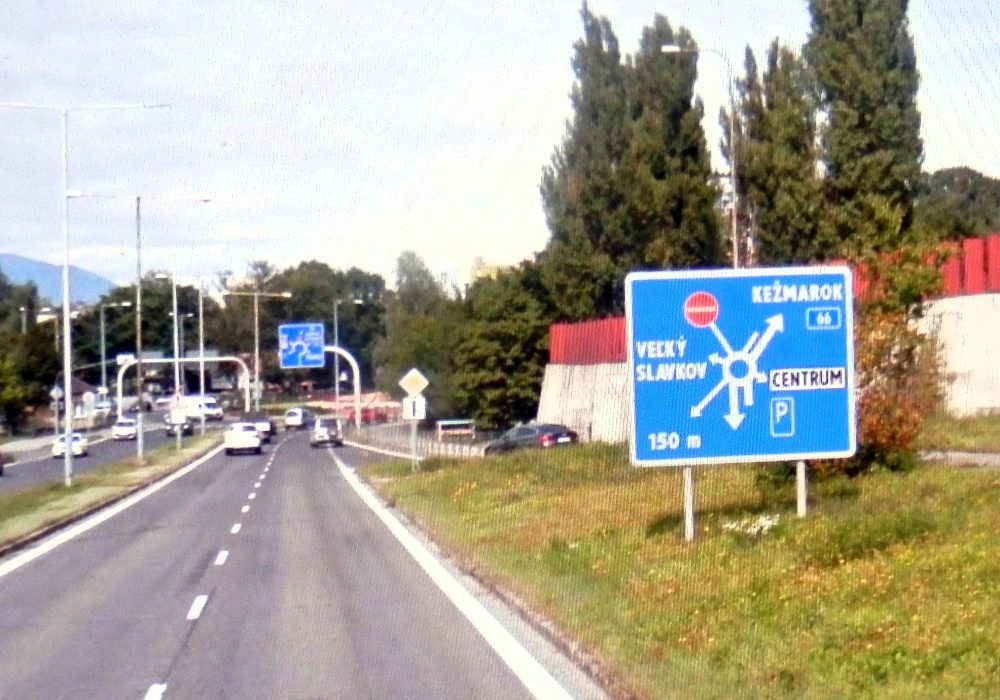- Basic Road Traffic Rules Information
Road traffic rules are stipulated by the Road Traffic Act and are conveyed through traffic signs in the Traffic Sign Regulation.
They derive from rules established by international agreements on road traffic, similar to other EU member states.


The speed limit can be reduced or increased by traffic signs. If the speed limit indicated by a traffic sign is higher than the general one, it applies only to vehicles ≤ 3500 kg without a trailer.
Basic information about the general speed limit is provided at border crossings into the Slovak Republic through traffic signs:

Alcohol and Driving – Zero Tolerance
Drugs and Driving – Zero Tolerance
Emergency Lane.
If a traffic jam occurs on a highway or a divided road outside a town with at least two lanes in one direction, the driver must allow the creation of an emergency lane in the middle between the two lanes.
In sections with more than two lanes, the lane is formed between the left lane and the adjacent lane.
When creating an emergency lane, the driver may enter areas where it is otherwise prohibited, as long as it does not endanger other traffic participants. Only vehicles designated by law can use the emergency lane.
Tram Crossing the Path of Another Vehicle.
A tram crossing the path of a vehicle traveling on its right or left side and signaling a change of direction has the right of way.
Daytime Running Lights.
A motor vehicle must have its low-beam headlights on or equivalent lighting during travel. In reduced visibility, daytime running lights can be used instead of low-beam headlights.
Mandatory Use of Safety Clothing.
The driver of a motor vehicle equipped with safety clothing must wear safety clothing if staying on the roadway outside the vehicle during emergency stopping, especially in the case of vehicle breakdown or due to a traffic accident.
Use of Winter Tires.
Tires marked with a mountain symbol or tires labeled “M+S,” “M.S,” or “M&S” are mandatory for passenger cars on all axles if there is a continuous layer of snow, ice, or frost on the road.
Use of Phone While Driving.
While driving, a driver must not hold or otherwise operate a telephone or other telecommunication, audiovisual, or similar device except when using a hands-free system or performing an activity unrelated to driving.
- Mandatory Equipment for Passenger Cars.
Homologated portable warning triangle, safety reflective clothing (according to EN ISO 20471) such as a vest, overall, pants, jacket, or raincoat; safety reflective clothing should be placed within reach of the driver’s seat, spare wheel (rim with tire) of the prescribed type and size, key for wheel nuts or screws, and a jack, first aid kit according to the vehicle registration state’s regulations.
- Traffic Accident and Damage Event.
A traffic accident is an event in road traffic directly related to vehicle traffic that results in:
death or injury to a person, malfunction of the road or generally beneficial equipment, leakage of hazardous substances. In the event of a traffic accident, you must stay at the scene, take measures to save lives and property, and call the police. The emergency call number is 112.
An event in road traffic resulting in damage directly related to vehicle traffic is considered a damage event.
In the case of a damage event, participants must complete and sign the European Accident Statement (EAS) form.
For more information on traffic accidents…
- Sanctions for Violating Road Traffic Rules.
Violation of road traffic rules is sanctioned as an offense against the safety and smooth flow of road traffic.
Types of sanctions:
reprimand, fine, driving ban, confiscation of items.
Fines.
Fines are imposed by a police officer during road traffic control or by the administrative authority (police) in administrative proceedings. An overview of fines can be found in the fine scale imposed by the police in block proceedings.
The fine scale is advisory. The police officer primarily follows the Law on Offenses when addressing a violation of road traffic rules during traffic control.
Administrative Proceedings.
The administrative authority, when determining a sanction, proceeds according to § 22 of Act No. 372/1990 Coll.
In addition to a fine, the administrative authority may impose a ban on driving motor vehicles for certain violations. For some violations (e.g., related to alcohol or drugs), a ban must be imposed.
For the violation of certain road traffic rules, the holder or owner of the vehicle, to whom a fixed fine is imposed, is responsible. More information can be found in Act No. 8/2009 Coll. (§ 139a).
Frequently Asked Questions What do I need to drive a motor vehicle?
To drive a motor vehicle in Slovakia, you must possess a valid driver’s license, with the relevant category recorded. The vehicle must have a registration document issued by the state of its registration, which the driver must present to the relevant authorities upon request. The vehicle must have a registration number on both the front and rear sides (motorcycles only on the rear).
What powers does a police officer have?
In addition to the authority to impose fines during road traffic control, a police officer has the authority to seize:
driver’s license, registration certificate, plates with registration number. Can I pay a fine by bank transfer?
You can pay a fine from abroad by bank transfer. More information can be found on the Ministry of the Interior’s website. The nearest police unit or the Traffic Police Department of the Police Presidium (odpppz@minv.sk) can provide information or advice to citizens.
